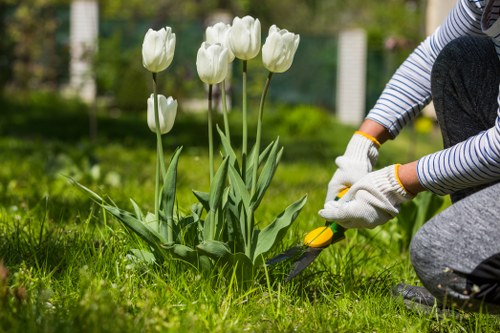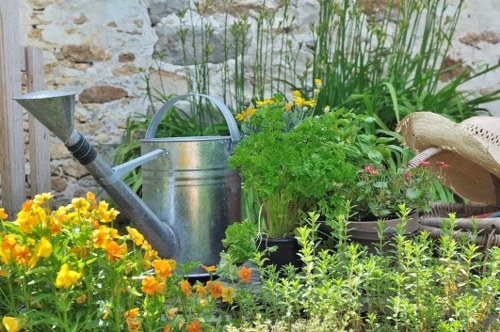Transform Your Outdoor Space: Landscaping in Bill's Garden

Introduction to Landscaping in Bill's Garden
Welcome to Bill's Garden, where the art of landscaping meets creativity and functionality. Whether you're looking to enhance your home's curb appeal or create a serene backyard oasis, landscaping plays a crucial role in shaping your outdoor environment.
In this article, we'll explore various aspects of landscaping in Bill's Garden, providing you with insightful tips and ideas to transform your space into a beautiful and sustainable haven.
From selecting the right plants to designing aesthetically pleasing layouts, our comprehensive guide covers everything you need to know to achieve a stunning landscape.

Planning Your Landscape Design
Effective landscape design begins with careful planning. Consider the following steps to ensure a successful transformation of your outdoor space:
- Assess Your Space: Understand the size, shape, and existing features of your garden.
- Define Your Goals: Determine what you want to achieve, whether it's relaxation, entertainment, or increasing property value.
- Budgeting: Set a realistic budget to guide your project and prioritize essential elements.
By addressing these factors, you can create a tailored plan that aligns with your vision and practical needs.

Choosing the Right Plants
Selecting Native Plants
Opting for native plants is a sustainable choice that supports local ecosystems. Native species are well-adapted to the climate, requiring less water and maintenance.
Benefits of Native Plants:
- Low maintenance and drought-resistant
- Promotes biodiversity
- Enhances the natural beauty of your garden
Incorporate a variety of native plants to create a diverse and resilient landscape.
Incorporating Seasonal Blooms
To maintain visual interest throughout the year, include plants that bloom in different seasons. This ensures your garden remains vibrant and colorful no matter the time of year.

Design Elements and Features
Hardscaping Components
Hardscaping refers to the non-living elements of your landscape. Key components include:
- Patios and Decks: Provide spaces for outdoor seating and gatherings.
- Walkways: Guide visitors through your garden while adding structure.
- Fencing and Walls: Offer privacy and define property boundaries.
Choosing Materials:
Select materials that complement your overall design and are durable in your local climate.
Water Features
Incorporating water elements like fountains, ponds, or waterfalls can add a soothing ambiance to your garden. These features also attract wildlife, enhancing the ecological value of your landscape.

Sustainable Landscaping Practices
Water Conservation
Implementing water-efficient systems is essential for sustainable landscaping. Consider the following practices:
- Irrigation Systems: Use drip irrigation to minimize water waste.
- Mulching: Retain soil moisture and reduce evaporation.
- Rainwater Harvesting: Collect and store rainwater for garden use.
Soil Management
Healthy soil is the foundation of a thriving garden. Regularly amend your soil with organic matter to improve fertility and structure.
Native Wildlife Support
Create habitats for local wildlife by planting diverse flora and providing shelter options. This not only supports biodiversity but also enhances the natural beauty of your garden.

Seasonal Landscaping Tips
Spring
Spring is an ideal time to plant new flowers and shrubs. Focus on:
- Planting bulbs for early color
- Pruning trees and shrubs
- Adding fresh mulch
Summer
Maintain your garden during the hot months by:
- Ensuring consistent watering
- Managing pests organically
- Providing shade for delicate plants
Autumn
Prepare your garden for winter by:
- Raking fallen leaves
- Protecting plants from frost
- Planting hardy perennials
Winter
Use the winter months for planning and maintenance:
- Designing next year's landscape
- Clearing debris
- Maintaining tools and equipment

Lighting and Ambiance
Outdoor Lighting Options
Proper lighting enhances the beauty and functionality of your garden after dark. Consider the following options:
- Path Lights: Illuminate walkways for safety and aesthetics.
- Spotlights: Highlight key features like trees or sculptures.
- String Lights: Create a cozy and inviting atmosphere.
Energy-Efficient Solutions
Opt for LED lighting and solar-powered fixtures to reduce energy consumption and environmental impact.
Creating Ambiance
Use lighting to set the mood in different areas of your garden. For example, soft lights near seating areas promote relaxation, while vibrant lighting can highlight vibrant plantings.

Maintenance Tips for a Lush Garden
Regular Pruning and Trimming
Keep your plants healthy and well-shaped by performing regular pruning and trimming. This encourages growth and prevents overgrowth that can detract from your garden's appearance.
Weeding
Eliminate weeds promptly to reduce competition for nutrients and maintain the integrity of your plantings.
Soil Health
Maintain soil health by adding compost and organic fertilizers. Healthy soil supports robust plant growth and resilience against pests and diseases.
Pest Management
Implement integrated pest management strategies to control pests without relying heavily on chemicals. Encourage beneficial insects and use natural repellents.

Adding Decorative Elements
Garden Sculptures and Art
Incorporate artistic elements like sculptures, wind chimes, or decorative stones to add personality and visual interest to your garden.
Seating Areas
Design comfortable seating areas where you can relax and enjoy your garden. Consider incorporating benches, hammocks, or outdoor furniture that complements your landscape style.
Water Features
As mentioned earlier, water features not only enhance beauty but also create soothing sounds that contribute to a peaceful environment.

Innovative Landscaping Ideas
Vertical Gardens
Maximize space and add greenery with vertical gardens. These are especially effective in smaller areas and can be customized with a variety of plants.
Smart Irrigation Systems
Incorporate technology into your landscaping with smart irrigation systems that optimize water usage based on weather conditions and soil moisture levels.
Eco-Friendly Practices
Adopt eco-friendly landscaping practices such as xeriscaping, which reduces the need for irrigation, and using recycled materials for hardscaping elements.

Final Thoughts on Landscaping in Bill's Garden
Transforming your outdoor space through thoughtful landscaping can greatly enhance your quality of life and increase the value of your property. By implementing the strategies and ideas discussed in this article, you can create a beautiful, sustainable, and functional garden that reflects your personal style.
Remember, successful landscaping requires planning, patience, and ongoing maintenance. Embrace the process and enjoy the rewards of a stunning garden tailored to your preferences.
Ready to transform your garden? Contact us today to schedule a consultation and start your landscaping journey with Bill's Garden.

Frequently Asked Questions
How long does a landscaping project take?
The duration of a landscaping project varies based on the scope and complexity. Typically, small projects can be completed in a few weeks, while larger transformations may take several months.
Can I landscape my garden myself?
Yes, with proper planning and resources, you can undertake DIY landscaping. However, for more intricate designs or professional results, consider hiring a landscaping expert.
What is the cost of landscaping in Bill's Garden?
Costs depend on factors such as project size, materials used, and labor. It's best to obtain a detailed quote tailored to your specific needs.
How do I maintain my landscaped garden?
Regular maintenance includes watering, pruning, weeding, and monitoring plant health. Implementing sustainable practices can also reduce maintenance efforts.
For personalized advice and professional landscaping services, book your service now with Bill's Garden.